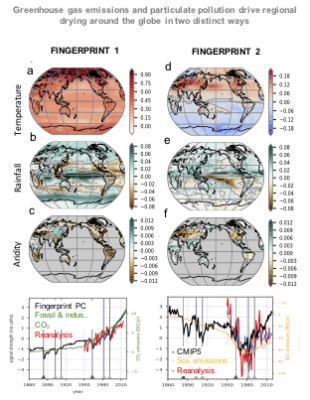Human Influence on Joint Changes in Temperature, Rainfall and Continental Aridity
Large-scale mechanisms causing regional drying are not well understood. Can we explain why arid conditions are spreading worldwide? Or why the western United States is getting increasingly arid since the 1980s while the African Sahel has simultaneously recovered from its prolonged drought? Are these two regional events independent or are they connected by large-scale mechanisms? Research scientists from Lawrence Livermore National Laboratory in collaboration with colleagues from the Canadian Centre for Climate Modelling and Analysis and from Columbia University use climate model simulations and observational data to reveal that since 1950, human-produced greenhouse gases (GHGs) and particulate atmospheric pollution have influenced global changes in temperature, precipitation, and regional aridity in two distinct ways. These two human “fingerprints” – signatures of large-scale mechanisms conducive to regional drying – are statistically identifiable in observations.
This research highlights that:
- Reliable simulation of observed hydroclimate changes requires combined forcing by GHGs, the effects of anthropogenic aerosols, and large volcanic eruptions.
- The climate simulations that most reliably reproduce the observed changes in temperature, rainfall, and aridity are those with the most complete representation of the impacts of manmade aerosols on climate.
- The use of a relatively new regression-based fingerprinting technique was required to account for the complex temporal behavior of the forcings by (and responses to) the slowly evolving increase in GHGs, the evolution of particulate pollutants, and the episodic effects of volcanic eruptions.
- Understanding expected future changes in both the mean state and hemispherically asymmetric forcings is an essential requirement for making reliable predictions of 21st-century hydroclimate changes.
Using an innovative fingerprint method capable of accounting for the complexity in the time evolution of well-mixed greenhouse gas (GHG) forcing and of geographically distributed anthropogenic aerosols, the team has identified two main “fingerprints” through which temperature, precipitation, and aridity have changed since 1950 in coordinated ways. The dominant fingerprint FM1(x) is characterized by a slowly evolving global warming, intensified wet-dry patterns, and progressive large-scale continental aridification, largely driven by multi-decadal increases in greenhouse gas (GHG) emissions. The second and more subtle fingerprint FM2(x) captures a pronounced temperature contrast between the Northern and Southern Hemispheres, controlled by the cooling influence of particulate pollution emitted from Europe and North America up until the 1980s. This temperature contrast moved the tropical rain belt southwards, away from the cooler Northern Hemisphere, causing more rainfall over the Western U.S. and less over the Sahel and India. After pollution regulations were put the place in following the Clean Air Act, and also due to the GHG-induced warming of Northern Hemisphere landmasses, the tropical rain belt shifted back northward after 1980, bringing less rainfall to the Western U.S. and more to the Sahel. Both fingerprints are statistically identifiable in observations of joint changes in temperature, rainfall, and aridity during 1950-2014.

